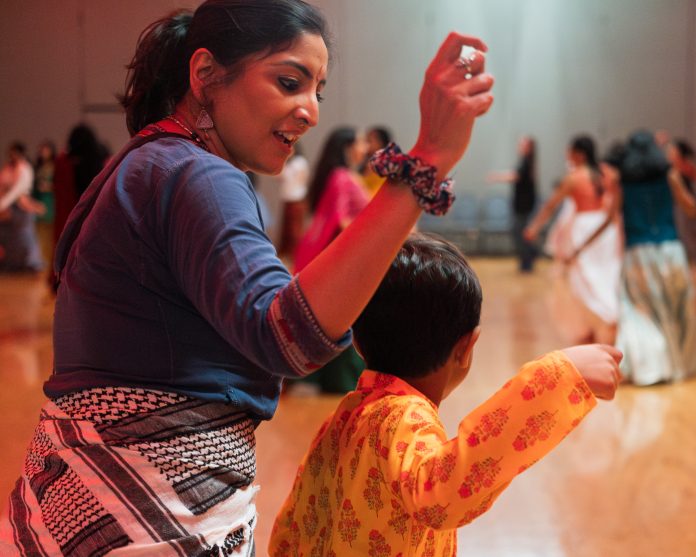Friday, Oct. 4, the lights in the Sadler Center’s Chesapeake rooms were dimmed and the smell of paneer began wafting into the Atrium. The College of William and Mary’s Afsana dance team came together in collaboration with South Asian Interfaith Organization to host their annual Garba Night celebration. The festivities featured performances from Afsana, dance lessons for attendees, presentations about South Asian culture and a spread of foods from the region.
In one of the presentations delivered by SAIO, it was explained that in many South Asian cultures, the Garba dance is traditionally performed throughout the Navratri, a nine-day festival that celebrates the Hindu deity Durga, the feminine form of divinity, and her nine forms, with each of the nine nights celebrating one of the different forms. While Navratri is celebrated many ways throughout the South Asian subcontinent, the Garba dance itself is a community circle dance that originates in the Northwestern Indian state of Gujarat.
The night began with dance lessons from the captains of Afsana. Afsana co-captain Arya Rajesh ’26 noted that the team chose easier dance moves from the Gujarati region that they could easily teach. Additionally, Rajesh highlighted how dancing is used in South Asian culture as a form of communication and expression.
Afsana member Himani Radva ’28 was raised in India and shared how participating in the dances allowed her to connect to her home.
“It brings me back to Indian roots, because I am Indian, and I’ve been in India for a super long time,” Radva said. “So obviously, coming here, I’m not going to have that much touch with my Indian roots. So I’m happy that there are nights like this that are here for me too.”
Attendee Anjali Krishnan ’27 is also from India, and she said her family celebrates with Garba each year. Krishnan explained how coming to the College’s Garba night celebration allowed her to celebrate the important holiday away from home.
“It helps with homesickness and it also helps me find my own space on campus,” Krishnan said. “These traditions are so familiar to me. It’s what I grew up with, and it just helps me find my roots. It’s so helpful with staying grounded and staying happy.”
Hindu, Sikh and Jain Students Association member Pooja Muthuraj ’25 said she was most excited to learn the Garba dance and see celebrations from other parts of South Asia.
“I think there’s such an incredible energy that you get when you’re dancing with a group of people who are all new to it and all super excited to learn about a culture that might not be their own,” Muthuraj said. “Like for me, personally, even if I am Hindu, Garba is not something that my family traditionally practices. So it’s a new tradition for me and something that I really love learning about and engaging in.”
While some attendees participated in the dance circle, others had the option to decorate Dandiya sticks. The sticks are used to keep the beat of the dance and symbolize the swords used by the goddess Durga during her battle with the demon Mahishasura.
SAIO vice president Tanvi Padole ’25 explained that the organization partnered with Afsana to include other cultural aspects of the festival, like the Dandiya stick decorating.
“We wanted to be able to bring our cultural and religious knowledge into something like this, because this is an inherently religious activity,” Padole said.
During dance breaks, the SAIO executive board gave presentations about the different festivities held during Navratri and how it is celebrated across the South Asian subcontinent. For example, in Southern India, somber, decorative altars are created to honor Durga, while in Eastern India, the nighttime sees people visit temporary temples that are constructed throughout cities. SAIO president Meeran Khan ’25 also noted how bringing in different activism organizations can bring awareness to different social problems experienced by the South Asian community, like environmental issues and domestic abuse.
Padole emphasized that the presentations were important to give context as to what the different celebrations mean and represent.
“I’ve noticed at a lot of these cultural religious events you see a lot of people coming just for the food and sitting down and then leaving. We did not want that to happen,” Padole said. “We wanted people to know that this is not just about the food. It’s about having people come over and really understand what the meaning behind is. It is for people like us. This is a very important holiday for a lot of people, because it’s celebrated across India.”
Khan mentioned that the festivities of the event were also adapted to be celebrated in the United States, but that they still retain many features that are seen annually in India.
“Specifically in South Asia, there will be giant fields and all throughout the nights people go with their friends and get dressed up and everything,” Khan said. “It’s also a time to meet other youth. In America, especially in New Jersey and places with higher Gujarati populations, you’ll get in gymnasiums and different community centers and there’s huge events.”
For Khan, coming together with people that share his culture has helped create a very important safe space for celebration. He reflected on how, being a religious minority, he appreciates having a space to share cultural traditions.
“I feel like [as] a South Asian, sometimes we don’t really talk about our politics back at home because we think it separates us as diaspora people,” Khan said. “But within the diaspora, we see a lot of the things that exist back at home that we bring over here, so it’s important to talk about it. Having a space where people can process that sort of information and learn more, it’s a very important space to have, and I’m very grateful for it.”

